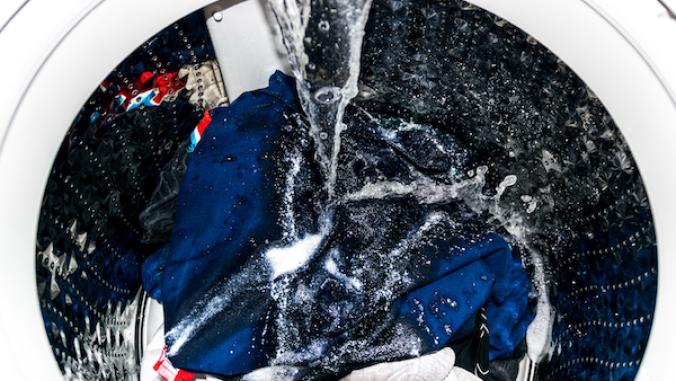This article is sponsored by Procter & Gamble.
Today’s global challenges and consumer expectations require that companies embed sustainability and corporate citizenship into their DNA. At P&G, this is something we’ve done since the beginning through our products portfolio — through our brands such as Tide.
Tide, which has its own social and environmental commitments, is on a mission for every load of laundry to do a "load of good," which includes a focus on decreasing the environmental impact of laundry and increasing the social impact of clean clothes. Tide’s Ambition 2030 includes measurable short-term goals along this journey and spans Tide’s value chain, from manufacturing, packaging and consumer use to the communities that Tide serves.
As P&G works to decrease the environmental footprint of Tide laundry, we are acutely aware that sustainability and cleaning performance are inextricably linked, and that we can’t trade one for the other. If products do not perform, consumers will turn to "compensating behaviors" — such as turning to warm/hot cycles, rewashing, pre-treating or overdosing — which uses more water and energy, and generates more waste. As Tide strives to maintain and increase consumer satisfaction while mitigating our environmental footprint, continuous process and product innovation are the bedrock of the strategy.
Here are three ways Tide embeds sustainability into its strategy:
1. Transforming ideas to market innovations
Innovation is essential for developing solutions that are high performing, sustainable and create value for consumers. One of the first sustainability-led innovations in the detergents sector, brought to life by Tide, was the idea of offering consumers more concentrated detergent forms to enhance critical active ingredients and reduce those that are not critical to remove stains. More than a quarter of a century of innovation resulted in Tide moving first from powder to liquid and subsequently to PODS. Tide PODS deliver the same number of laundry loads as liquid formats, but require smaller, lighter packaging sizes that result in less waste, both at the point of manufacture and in people’s homes. Lighter packs also deliver emissions savings during transportation, helping to lower Tide’s overall carbon footprint.
Another area where we continue to transform ideas into new in-market innovations is packaging. P&G Fabric Care is focused on driving circular packaging solutions by using less and better plastics. Tide’s efforts in this space date back decades, including a Tide-led coalition to introduce a recycling system for colored plastics in the 1980s. Most recently, Tide’s 2030 goals are to cut the use of virgin plastic by half per unit sold and to use 100 percent recyclable packaging for all products. As of 2022, Tide POD tubs are made with High Density Poly Ethylene (HDPE) plastic, allowing 16 million tons of plastic to become recyclable, and lowering the CO2 footprint by 20 percent. Today, 100 percent of Tide liquid detergent bottles are recyclable and made with at least 25 percent Post-Consumer Recycled (PCR) plastic. And we have also introduced new packing solutions, including the Tide Eco-Box for liquid detergents, which uses 60 percent less plastic compared to traditional laundry bottles. More broadly, innovations such as greater compaction have aided us in reducing and removing unnecessary packaging for the PODS format.
2. Consider the full picture
While packaging and transport emissions savings are important, decarbonizing laundry means addressing all parts of the value chain. According to Life Cycle Assessments (LCAs) — which assess a product’s total environmental impact from cradle to end-of-life — on average two-thirds of the environmental impact of laundry comes from the consumer use phase, primarily by the energy required to heat water in the laundry cycle. That means that the single greatest opportunity to drive positive impact for the environment is to develop a product that cleans and removes stains in cold water.
Considering that in North America alone, more than 30 billion loads of laundry are completed each year, the seemingly small change of turning the temperature dial down can add up. Indeed, Tide has set a goal to turn three in every four laundry loads in the U.S. to cold water by 2030 — a move that we estimate would help avoid 27 million tons of greenhouse gas emissions — or more than 10 times P&G’s annual global operations.
Turning to cold water is not just better for the planet, it also creates real value for consumers. Switching from hot to cold laundry cycles could save households up to $150 per year on their energy bills. Additionally, washing in colder water extends the lifetime of clothing. An estimated 81.5 pounds of clothes in America are discarded to landfill each year, and temperature is a key driver of dye bleeding in washes, which ultimately leads to colors fading and dye transfer to other clothes. Turning to cold is an easy way to combat this as decreasing the wash temperature by as little as 10 degrees Fahrenheit, from 104 to 86, can reduce dye transfer by 30 percent. Extending the life of clothes by just nine months of active use would reduce carbon, water and waste footprints by as much as 30 percent for each item.
We believe in the power of cold, and we’re leveraging the might of Tide’s brand resources and marketing to start a "turn to cold movement," educating consumers about the benefits of cold water and encouraging them to wash in cold cycles most of the time.
3. Transform habits through innovation
Changing ingrained habits is not easy. People need to trust that in turning the temperature dial down, the clean they know and have come to rely on will not be compromised. This is where innovation comes in. Tide scientists have spent decades researching how to uniquely formulate our detergent to effectively remove stains and odors in cold water. One key breakthrough is the discovery of an enzyme produced by marine microorganisms which breaks down sticky molecules in cold temperatures. Inspired by this, our scientists have used their most technologically advanced tools to identify and transfer important features from over a million enzyme candidates into two of the lead enzymes used in Tide today. Trusted to deliver great performance in cold conditions, the discovery is a step-change in modern laundry. Enzymes break down soiling on fabric, making it easier for surfactants to remove the stain. On top of cold-water enzymes, Tide also contains a variety of surfactants, selected specifically because they combine to deliver maximum performance across different types of soiling, fabric, water hardness and water temperatures — especially in cold.
Thanks to innovations like this, we are starting to see the needle move towards cold washing. Back in 2020, less than half of laundry loads (48 percent) were washed in cold cycles. But as of 2022, the number of laundry loads washed in cold water had risen to 56 percent. If we are to meet Tide’s goal of three quarters of all laundry loads in the U.S and Canada being washed on a cold setting, we must continue to innovate to develop formulas that deliver an outstanding cleaning performance, time and time again, even in cold water. Only by building this consumer trust will we successfully change behavior and see washing on cold become the norm.

%20(1)cc6a.jpg)
